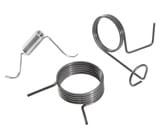 If you’ve ever wondered what is a torsion spring or how are they used, you’re not alone. With so many spring types available it’s often hard to decipher which spring may be required for a specific application. At James Spring we’re here to answer all of your spring questions!
If you’ve ever wondered what is a torsion spring or how are they used, you’re not alone. With so many spring types available it’s often hard to decipher which spring may be required for a specific application. At James Spring we’re here to answer all of your spring questions!
Torsion springs are a type of flat spiral coil or helical shaped spring used in applying a torque or store rotational energy. Unlike other springs such as compression or extension springs that require a linear force to push or a pull, torsion springs store and release rotational energy via torque as a measure of force. Torque causes the spring to rotate on its axis when applying or resisting a load. Thus, think of torque as the rotational equivalent of the linear force that powers compression and extension springs.
In applications, the ends of torsion springs are attached to other components or objects set to rotate around the center of the spring. The spring is generally close wound but it can also have pitch to reduce friction between the coils. Because torsion springs offer resistance to twisting or rotational applied force, they can be applied to devices that work clockwise or counter-clockwise, whatever the direction of the load requires. They can be designed to store and release angular energy such as a mousetrap or screen door or statically clamp a mechanism in place like a clothespin or clipboard. Therefore, torsion springs can hold objects in place or push them back to their original position.
Broadly speaking, springs are exceptionally common mechanical devices that are found in a wide variety of applications in nearly every industry. Mainly found in mechanical assemblies to provide a necessary type of force—compression, extension or torsion—it is no exaggeration to say that these devices are indispensable components in the manufacture of products great and small. The majority have a familiar coiled or helical shape, though there are other shapes like linear leaf springs found in motor vehicle suspensions. Whatever the mechanical assembly, all springs function to store mechanical potential energy that either pulls, pushes or resists, winds, supports, lifts, or even protects a device, component or object which, when the load is applied or removed, is subsequently released.
Torsion Spring Materials
Springs are usually made from spring steel that, in general, is a type of low-alloy manganese, medium-carbon steel or high-carbon steel with a very high yield strength. Springs are often made to specification using dedicated wire winding machines designed to wind wire around a given number of turns over a specific length to produce the necessary force constant required for the application.
Torsion springs are wound to function through a winding action. While set in a horizontal or vertical position, the spring is rotated and twisted against itself along its axis. The rotation on the axis of the torsion spring is designed to wind the coil tighter, which either stores or releases potential energy and thereby provides the power for the spring. The tighter the coil is wound, the more mechanical potential energy is stored in the spring. As the spring is rotated into position, once released, it is set to exert proportional force in the opposite direction equal to the force being applied.
Size Considerations
In size considerations, torsion springs range from miniature, like those used in electronic devices, to large industrial sizes used in the tailgates of dump trucks in heavy construction. When meeting design requirements for an application, the load should be in the direction of the wind. Also, the effects of friction and arm deflection on the torque should be factored as should space limitations. Performance and durability is improved when the spring is supported in place by a tube or rod. Keep in mind that as its wound, a torsion spring’s body becomes longer and reduces in diameter.
Torsion springs then are utilized in mechanical assemblies that require rotational or torque force. Their commercial applications are numerous and are commonly used in products that utilize or require hinges, counterbalances and lever return applications, or as couplings between concentric shafts like in a motor and pump assembly. They are generally mounted at three or more points with various types of end designs to facilitate mounting.
Finally, from large to small applications, torsion springs are commonly found in automobile doors, in agricultural equipment, swing-down tailgates, and industrial heavy-duty equipment, overhead doors on loading docks and warehouses, and semis and delivery truck doors. They are also used in everyday tools and items in and around the house—door hinges, window shades, ratchets, levers, clothes pins, clipboards, tailgates on pickup trucks, and garage doors.
If you’re in the market for torsion springs or any other type of spring product James Spring may be able to help. We offer custom wire forming as well as advanced capabilities including metal stampings and strip forms.

